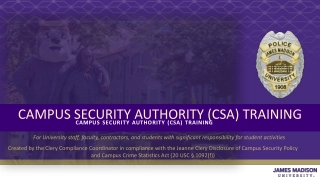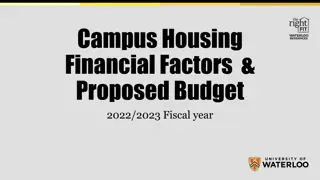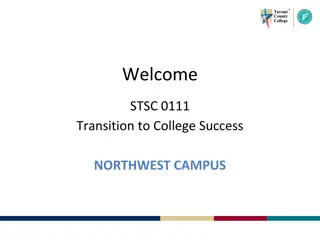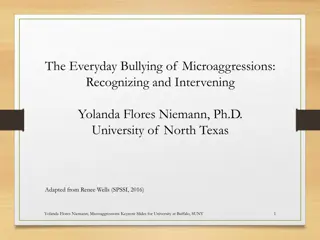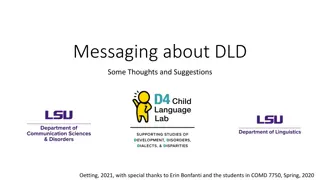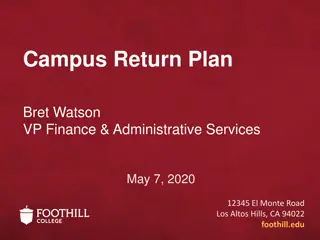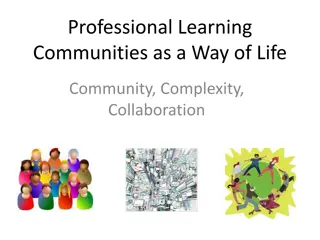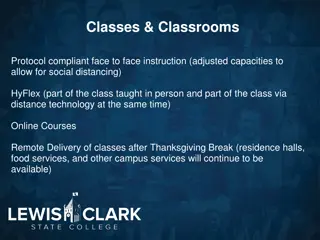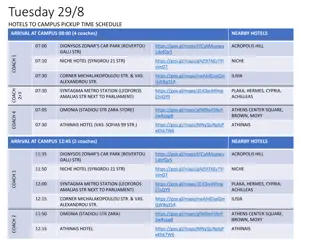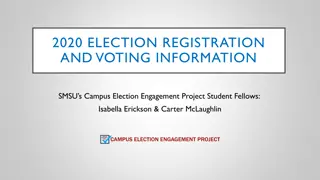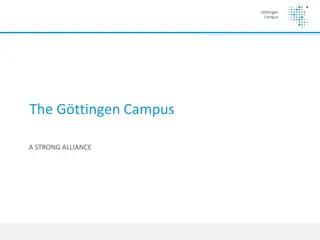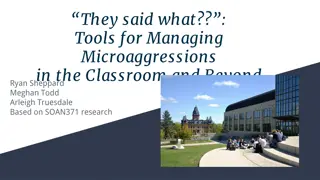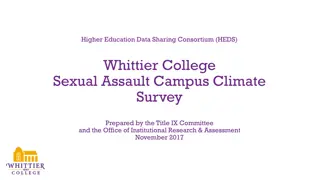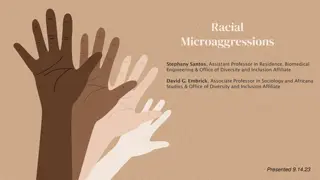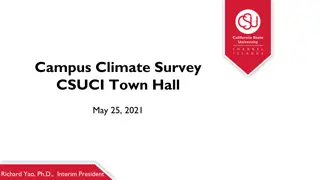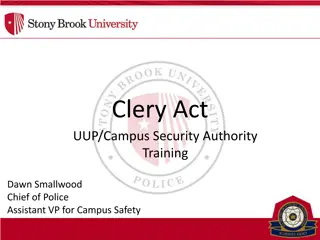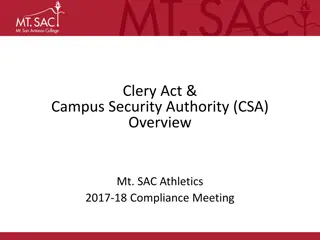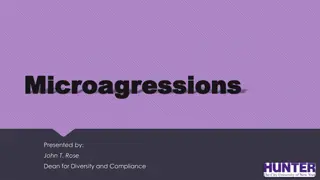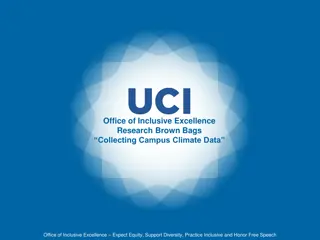Understanding and Addressing Microaggressions in Campus Communities
Explore the history and definition of microaggressions, identify different types like microassaults, microinsults, and microinvalidations, and learn about common themes of microaggressions such as appearance, intelligence, and religion. Discover techniques to minimize microaggressions and consider responses to such behaviors.
Download Presentation

Please find below an Image/Link to download the presentation.
The content on the website is provided AS IS for your information and personal use only. It may not be sold, licensed, or shared on other websites without obtaining consent from the author. Download presentation by click this link. If you encounter any issues during the download, it is possible that the publisher has removed the file from their server.
E N D
Presentation Transcript
Presented by: John T. Rose Dean for Diversity and Compliance Microagressions
Learning Objectives 1. Create awareness surrounding the common occurrences of Microaggresions within our campus community. 2. Explore the outcomes associated with the experience of microaggressions. 3. Discover techniques to minimize the occurrence of microaggressions 4. Consider potential responses when someone has been microaggressive
History The term microagression was coined by Harvard Professor and Psychiatrist, Chester Pierce, in 1970 who is Black. He was studying the persistent presence of stigmatizing representations of Black people in television. He defined it a subtle, stunning, often automatic and non-verbal exchanges which are put-downs of Black people Racial microaggressions are the brief and everyday slights, insults, indignities and denigrating messages sent to people of color sometimes by well-intentioned people who are unaware of the hidden messages being communicated. -Derald Wing Sue, Columbia University
Definition Verbal, behavioral, or environmental slights Often automatic and unintentional Occur in brief instances on a daily basis Communicate hostile, derogatory, or negative viewpoints Perpetuate a worldview of White supremacy and superiority 3 types: micorassault, microinsults, microinvalidations
Fusion Video Watch the Video
Microassaults Old-fashioned racism Uncommon Deliberate, conscious, and explicit Intention is to hurt, oppress, or discriminate (Dovidio & Gaertner, 2000) Examples: Refusing service to sexual minorities Displaying the hood of the Ku Klux Klan
Microinsults and Microinvalidations Not intentional. Typically occur due to underlying biases and prejudices outside of awareness. Microinsults Convey insensitivity, are rude, or demean an individual s identity or heritage. Microinvalidations Exclude, negate, or nullify an individuals thoughts or feelings
Themes of Microagression Appearance: Looking Different Ascription of Intelligence Color Blindness Denial of individual racism Pathologizing Cultural Values Assumptions of Criminality Myth or Meritocracy Second Class Citizenship Religion
Microagression in the Classroom Watch the Video
Theme Alien in Own Land Ascription of intelligence Color Blindness Microaggression You speak good English You are so articulate Message You aren t American It is unusual for someone of your race to be so intelligent Denies a person s color or racial heritage You are going to steal When I look at you, I do not seen color Following a customer of color around a retail store My best friend is Black Assumption of criminal status Denial of individual racism /bias I am immune because I have friends of color Your racial oppression is no different than my gender oppression As a woman, I know what you are going through Myth of Meritocracy Everyone can succeed in America if they work hard enough Dismissing an individual who brings up race/culture at work/school Taxi Driver passes a person of color to pickup a white passenger People of color are lazy or incompetent and need to work harder Pathologizing Cultural Values Leave your cultural baggage outside; you must assimilate Second Class Status You are likely to cause trouble or to travel to a dangerous neighborhood
Theme Gender Microagression Smile, you are too pretty for people not to see your smile A female doctoral student continues to receive emails addressed as Dear Sir I like you but why do others have to shove it on our face So whose the man in the relationship? Message Your appearance defines what people think of you It is unlikely for someone of your gender to be pursuing an advance degree in this field The LGBTQ experience is offensive and abnormal Implies that normal relationship must be between between a man and a woman You can t function independently Sexual Orientation Disability Without being asked to a man helps a disabled person board a train Youdon t look Jewish! Religion All Jewish people look the same Environmental Television shows/movies without representation of people of color or representation in limited roles A college with all buildings named after white hetero-sexual males You are an outsider and do not exist and/or only exist to serve those count You do not belong here
Internal Dilemma Experiencing a microagression may lead to the following intrusive cognitions: Did I interpret that correctly? Did she say what I think she said? What did he mean by that? Should I say something? Saying something may make it worse They ll probably think I am overreacting Speaking up is going to hurt more than helps
Impact Racial microaggressions create a hostile and invalidating climate for people of color,saps their spiritual and psychic energies, and their cumulative nature can result indepression, frustration, anger, rage, loss of self esteem, anxiety, etc. -Derald Wing Sue
Productive Responses Take a deep breath Assume offense was not the intent Explain how the slight may be interpreted by others As a follow-up question e.g. who are referring to when you say that? What do you mean? Identify individuals you feel comfortable discussing issue with (e.g. family, friends, cohort member, mentors)
Productive Responsecontinued What about when the perpetrator denies having been offensive: Ask yourself: o Will further conversation will be beneficial AND productive? What is my current level of stress? o Am I able to respond non-emotionally? If you decide to discuss further: Take a deep breath! Reiterate that you are not blaming the person, only expressing the way the comment/action made you feel. Explain that instances occur daily and others have made similar comment/actions. Be open to their input and expression of their feelings.
Next steps Individuals Recognize that dismissive attitudes are harmful. Engage in self-reflection to identify times that you may have been microaggressive in your personal and work life. Participate in continuing education activities. Avoid making assumptions and labeling individuals. Institutions Foster inclusive and supportive environments. Collaborate with groups and organizations who are committed to addressing issues of diversity and inclusion. Offer trainings and opportunities for continuing education and diversity workshop
Next steps...continued Employees: Recognize that microaggressive instances occur on a daily basis on our campus, that community members are likely to experience. Foster an environment that encourages community members to discuss occurrences openly. This may be accomplished during initial meetings and/or through other contact If/when you realize that you have made a statement or conducted a microaggressive action, approach the community member and acknowledge the occurrence. Foster discussions surrounding diversity with colleagues and supervisors. Discuss microaggressive instances with perpetrators first before addressing their superior. Recognize that slights are often unintentional.


